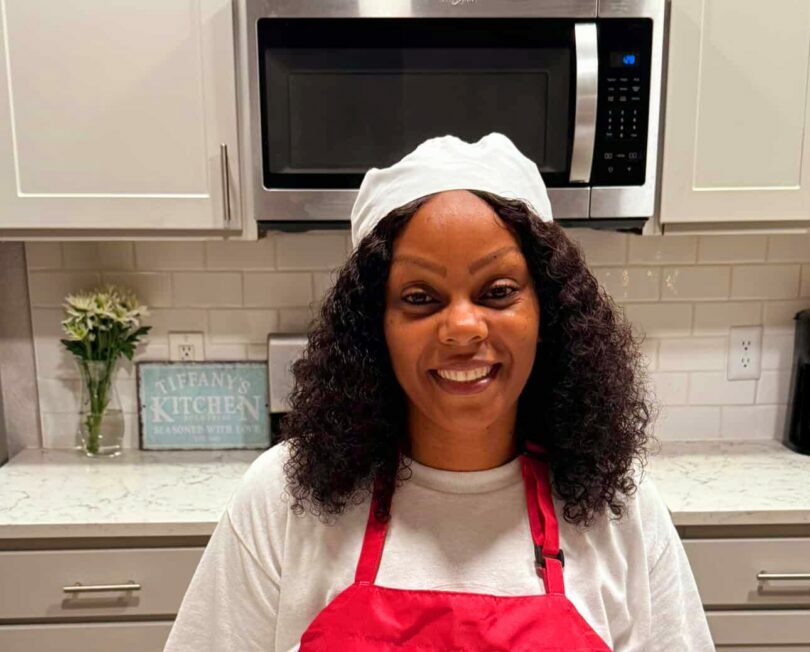We recently connected with Sarah Branson and have shared our conversation below.
Sarah, thank you so much for making time for us today. We’re excited to discuss a handful of topics with you, but perhaps the most important one is around decision making. The ability to make decisions is a key requirement for anyone who wants to make a difference and so we’d love to hear about how you developed your decision-making skills.
It was a warm spring night when my partner, Sage called me. “Anna thinks things are starting.”
Anna lived a good distance from me, so I said, “Okay. Let’s head over now. If labor slows down, we can always sleep there.” I thought about the spacious house far out in horse country and knew there’d be plenty of room for us to catch some sleep. And I was just going as the assistant this time, as Sage had begun acting as the primary midwife since I was about to move out of state, leaving my established practice and amazing clients.
We arrived and as was typical for Anna she had tea and snacks out for us. She was contracting regularly, and her mother and other family had also arrived, but it was clear that she was still early in her labor and had not yet turned the corner to active labor. However, since it was her fifth birth, Sage and I both knew that corner could come up quickly, so we listened to the baby, checked Anna’s vitals, chatted a bit, set up our supplies, and then decided to go upstairs and rest.
I never fully sleep at a client’s home. While my eyes might be shut and my own breathing might be slow and regular, my ears are constantly listening for a change in my client’s breathing and vocalization signifying a shift in the labor process. But Anna was not my client, “Sage is the midwife, Sarah.” I reminded myself. “She’ll let you know when she needs an assistant.” With that thought I attempted to shut off my brain and get a bit of sleep.
Not ten minutes later I heard Sage get up and go downstairs. I willed myself to stay put. Having been the primary midwife for all the years of our friendship and professional relationship, I knew that my presence might cause Sage to defer to me and fall back into her assistant role, so I lay on the comfy bed and tuned my ears to listen for Sage’s call. Eventually it came.
“Hey, Anna is getting active and wants to get in the tub.”
I gave a stretch and replied, “I’ll be right down.”
She was in her living room in front of a fireplace that was not needed on this warm night. The furniture was pushed aside, and the birth tub was almost full. Anna’s partner, Jason, was rubbing her back as she sat in the tub and Sage was listening to the baby whose heart rate dropped with the contraction, but then came back up as Sage suggested Anna shift her position.
Then the next contraction came, and Sage kept the doppler on and we both heard the rapid hoofbeats of the baby’s heart precipitously decline, dropping lower and lower from the 130s heading rapidly to the 70s. “Okay, Anna, baby needs you to shift positions again.” She willing shifted as she had before, but this time the heart rate stayed low.
All thoughts of my role an assistant left my brain as I slipped into crisis management.
I stepped into the tub. “I need to do an exam to see what’s going Anna” Sage kept the doppler on and the heart tones were plodding along. Anna nodded her consent, and I reached down into the water and then into Anna. It is not uncommon for a baby that rapidly descends into the birth canal to have a drop in their heart rate, so my expectation was that I would reach in a tiny bit and bump into a hard little head. Instead, I reached far up, feeling the head, some cervix and then, terrifyingly, a large mass of pulsing cord pinched between the baby’s head and Anna’s body. I put my two fingers on the little head and pushed up to alleviate some of the pressure on the cord as I said to Sage and the room. “It’s a cord. Call 911. Anna, you are going to get out of tub and get on the couch with your butt up in the air with my fingers still in you.” Sage was already making this happen. Within a few seconds, Anna was in position on the mustard- colored couch, me right behind her. The heart rate was slightly better, but still dangerously low.
My focus shifted for a moment from Anna and her baby to the goings on around me. That was when I realized that the family was having problems finding a phone to call 911. In a flash I realized it would take far too long to get the ambulance all the way out here, load her in, get her to the hospital and prepped for a cesarean. Then the words of Dr. Joe, the tall, lanky physician with an easy smile from a quarter century earlier in my career came to me. “Sometimes with these multips [women who have birth before] it’s faster to just have them push.”
“Okay, Anna, I want you push with next contraction.”
Her voice had that vulnerable tone of a person in labor and the desperate tone of a mother deeply afraid for her child’s life, “But I don’t have the urge.”
“I know. But this baby needs to be born now. So, I want you to push with all you have.”
The next contraction came, and Anna roared out a primal groan as she pushed with all her might. The baby descended and crowned and slipped into my hands all with that one heroic push. I leaned over to begin rescue breaths I knew the child would need, when Sage touched my arm. “Sarah, no, look:”
The little boy in my hands was pink and howling. Sage and I looked at each other in awe and then passed the baby to his mother.
As Sage took over care, I reflected on how I decided on that course of action. And I have reflected on it many times since. I am at heart a thin slicer– many times I must make rapid assessments and choices based on limited information. But I also draw on understanding, skills, and learning that have accumulated over the past thirty-plus years of being a midwife and forty-plus years of being an adult.
This blend of decision-making style that allows me to trust my brain and my judgement in moments of crisis has served me well not only in my career as midwife, but as a parent, teacher and now writer. You’ll find that my protagonist, Kat Wallace, has developed a similar style. Funny that.

Appreciate the insights and wisdom. Before we dig deeper and ask you about the skills that matter and more, maybe you can tell our readers about yourself?
I write books. I’d love to say I write books for a living, but at this stage in my career, that still feels like a bit of a stretch. Specifically, I am a feminist speculative fiction author, and as of the end of January—with the launch of North Country—I have seven books to my name.
If you had told me five years ago that I would become an author, I would have assumed your crystal ball was malfunctioning. For over 30 years, I was a midwife, supporting families in hospitals, birth centers, and homes. I also spent time teaching middle and high school science, both in Michigan and overseas. I loved being a midwife, and while I always enjoyed reading, watching, and even writing stories in high school and college, I never considered myself someone with a story to tell. Ask me why I didn’t pursue a doctorate in nursing, and my answer would have been simple: I never wanted to write anything longer than a page if I could help it.
But then, in early 2020, I took a job at a birth center in Connecticut just as the pandemic began. With a ninety-minute commute and frequent overnight shifts at the center, I found myself with a surplus of time—and my lifelong habit of playing imagination games reawakened. As a child, I filled long car rides with elaborate make-believe stories. As an adult, I entertained myself through tedious moments—waiting rooms, dull professional development videos—by creating imaginary scenarios.
Then, one day on my commute, I turned off the podcasts, audiobooks, and playlists and simply sat with my thoughts. That’s when Kat Wallace appeared. A young woman who had escaped enslavement and been taken in by a band of futuristic pirates, she settled into my passenger seat, pulled out her thigh dagger to clean under her nails, and began to tell her story. Her arrival—and her insistence on being heard—changed the course of my life.
What makes this moment so significant is that she arrived when many people are looking to wind down their careers and coast toward retirement. Instead, getting to know her and writing her story led me to push myself in unexpected ways—learning skills like boxing, shooting, and even flying a plane to ensure I could tell her tale authentically. People often ask how much of me is in my protagonist, but the real question is: how much of Kat has found her way into me?
Every day, I am amazed by the unexpected turns my life has taken as I embark on this creative journey. While I love the path I’m on, I’ve certainly wrestled with imposter syndrome along the way. But if there’s one thing I’ve learned, it’s that humans have an incredible capacity to change, adapt, and grow—at any age. My writing, and Kat, have given me a new way to see the world, and a new way to help others see it, too.

If you had to pick three qualities that are most important to develop, which three would you say matter most?
Stubbornness, stubbornness, and—oh yes—more stubbornness. Or, to put it more eloquently: tenacity, perseverance, and grit.
When I started this journey, I had no idea just how overwhelming the learning curve would be. If I had known everything I didn’t know, I might have shied away from the process, mumbling, Well, that’s just going to be too hard. But I had a story I wanted to tell, and that desire kept me moving forward. With the support of family, friends, and even strangers who became friends, I learned—about writing, plot structure, character development, the publishing process, formatting, and marketing. I made mistakes. I revised. I learned some more. And through it all, I stayed true to the story I wanted to tell.
For anyone embarking on a creative journey, my advice is this: stay focused on your dream but allow it to be flexible. Be open to growth and change. Don’t isolate yourself—something that can be especially difficult for those who lean toward introversion. Seek out a supportive community that understands your passion. There are many writing groups out there, both general and genre specific. Find them. Vet them. Let them be a source of encouragement as you navigate the transition from writing with passion to crafting a piece that moves others just as deeply.

What would you advise – going all in on your strengths or investing on areas where you aren’t as strong to be more well-rounded?
One of the most valuable lessons I learned during my decade as a teacher is that students should be given every opportunity to demonstrate what they’ve learned—but the mode of that demonstration can vary widely. Traditional tests, whether multiple-choice or essay-based (yes, I remember the days of the dreaded blue books), are just one way to measure knowledge. But so is writing a song, choreographing a dance, directing and acting in a play, or creating a piece of art.
I firmly believe that when we play to our strengths, we gain confidence—not just in our talents, but in our ability to persevere. We become more willing to take on challenges that might initially seem daunting, and when we stumble, we develop the resilience to try again. In this way, honing our strengths naturally helps shore up our weaker areas, and our belief in ourselves grows.
At Concord Academy, a charter school in Northern Michigan that integrated the arts into a traditional curriculum, I saw this philosophy come to life. As a science teacher, I had the privilege of running a science fair that looked a little different from the norm. Yes, there were the classic tri-fold display boards, but there were also students dancing the water cycle, others meticulously painting internal organs on a friend’s body and explaining their function as they walked the halls, and still others using visual art to craft stunning representations of scientific concepts. While every student still took traditional paper-and-pencil tests, their ability to express their learning through their strengths led to remarkable retention. Even now, years later, I hear from former students who vividly remember lessons we explored together.
Playing to your strengths isn’t about avoiding growth—it’s about building a foundation of confidence that allows you to tackle the things that challenge you. When we feel capable, we’re more willing to step outside our comfort zones, embrace failure as part of the process, and keep pushing forward. That’s where real growth happens.
Contact Info:
- Website: https://www.sarahbranson.com/
- Instagram: https://www.instagram.com/author_sarah_branson
- Facebook: https://www.facebook.com/sarah.branson.author




Image Credits
Sasha Dale Photography, LLC (headshot)
so if you or someone you know deserves recognition please let us know here.




